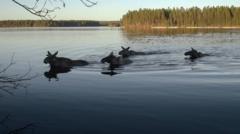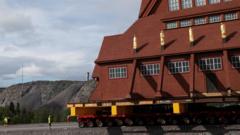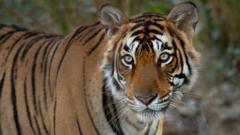Every spring, millions eagerly anticipate the annual migration of moose in northern Sweden, and this year’s broadcast of "The Great Moose Migration" has already captured significant attention. The round-the-clock livestream showcases the breathtaking journey of these iconic animals as they swim across the Angerman River to reach their summer pastures. This year's event commenced earlier than usual due to unseasonably warm weather and is being aired on SVT Play, the streaming service of Sweden's national broadcaster.
For the past six years, this unique program has gained a dedicated following, transforming into a "slow TV" phenomenon that many describe as mesmerizing and therapeutic. Cait Borjesson, 60, shares her love for the livestream, which she discovered during the Covid-19 pandemic, and now regularly takes time off work to relish the experience. “It’s unbelievably relaxing,” she says, highlighting the soothing sounds of nature that accompany the visuals, which allows viewers a slice of the wilderness from the comfort of their homes.
The broadcast has cultivated an engaged audience, showcased by a Facebook group with over 77,000 members who share their highlights and emotional responses to the migration. As the moose venture through Kullberg village and beyond, viewers are treated to a stunning view of Sweden's landscape captured by more than 30 cameras. Goran Ericsson, a dean at the Swedish University of Agricultural Sciences, explains that the migration has been occurring since the ice age, with 95% of moose in the region undertaking this journey every year.
The early migration this year, attributed to milder winter conditions, is part of a natural cycle. Research reflects an increasing preference for "slow TV," where viewers favor experiencing unfiltered nature sounds rather than added music or commentary. Minh-Xuan Truong, a researcher at the same university, notes that people appreciate the intimate connection with the forest that the livestream provides. With Sweden housing approximately 300,000 moose, affectionately referred to as the "King of the Forest," the broadcast continues to attract millions, reinforcing the bond between nature and viewers across the globe.
For the past six years, this unique program has gained a dedicated following, transforming into a "slow TV" phenomenon that many describe as mesmerizing and therapeutic. Cait Borjesson, 60, shares her love for the livestream, which she discovered during the Covid-19 pandemic, and now regularly takes time off work to relish the experience. “It’s unbelievably relaxing,” she says, highlighting the soothing sounds of nature that accompany the visuals, which allows viewers a slice of the wilderness from the comfort of their homes.
The broadcast has cultivated an engaged audience, showcased by a Facebook group with over 77,000 members who share their highlights and emotional responses to the migration. As the moose venture through Kullberg village and beyond, viewers are treated to a stunning view of Sweden's landscape captured by more than 30 cameras. Goran Ericsson, a dean at the Swedish University of Agricultural Sciences, explains that the migration has been occurring since the ice age, with 95% of moose in the region undertaking this journey every year.
The early migration this year, attributed to milder winter conditions, is part of a natural cycle. Research reflects an increasing preference for "slow TV," where viewers favor experiencing unfiltered nature sounds rather than added music or commentary. Minh-Xuan Truong, a researcher at the same university, notes that people appreciate the intimate connection with the forest that the livestream provides. With Sweden housing approximately 300,000 moose, affectionately referred to as the "King of the Forest," the broadcast continues to attract millions, reinforcing the bond between nature and viewers across the globe.



















